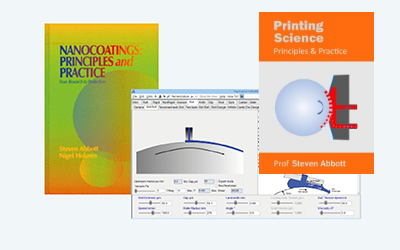Rayleigh Scattering
Quick Start
The science of scattering by particles is very hard. This app, plus the Mie one, provide two idealised cases that at least provide some guidance about the effects of particle sizes and refractive indices.
Here we let you mix two particle radii (varying the % R2, and factor in the RI of the medium and the particle. Scattering depends strongly on wavelength, so the graph shows a few wavelengths, plus whichever value, λ, you choose with the slider.
The output is how much scatter you would see at any given angle with respect to the light.
Scattering from surfaces is discussed in the Gloss app.
Rayleigh Scattering
Isolated nanoparticles such as exist as aerosols in the upper atmosphere or as small particles in dilute milk can scatter light. The intensity and angular distribution of the light depends on the wavelength of the scattering light, the particle size and the refractive indices, n, of the medium and particle. The intensity falls off with the square of the distance, R, from the scattering point. For simplicity this is set to 1μm. The theory was worked out by Lord Rayleigh starting in 1871.
Because we rarely have pure particles it is interesting to see the scattering from particles of different sizes with your chosen relative amount of each. Because scattering depends on r6 it needs very little of the large particles to overwhelm the scattering from the small ones.
Because of the λ4 dependence on scattering, the effects are much large in the blue region (down to 400nm) than in the red region (600nm). Hence in addition to the plot at your selected wavelength, scattering at 400, 500.. nm is shown.


